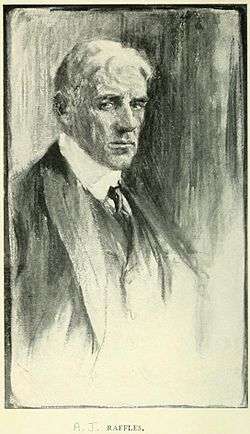A. J. Raffles (character)
| A. J. Raffles | |
|---|---|
 | |
| First appearance | The Amateur Cracksman |
| Created by | E. W. Hornung |
| Portrayed by |
Kyrle Bellew "Gentleman Jim" Corbett John Barrymore Gerald Ames House Peters Ronald Colman George Barraud David Niven Anthony Valentine Jeremy Clyde Nigel Havers |
| Information | |
| Nickname(s) | The Amateur Cracksman |
| Gender | Male |
| Occupation |
Cricketeer gentleman thief |
| Nationality | British |
Arthur J. Raffles is a character created in the 1890s by E. W. Hornung, brother-in-law to Sir Arthur Conan Doyle, the creator of Sherlock Holmes. Raffles is, in many ways, a deliberate inversion of Holmes – he is a "gentleman thief", living at the Albany, a prestigious address in London, playing cricket for the Gentlemen of England and supporting himself by carrying out ingenious burglaries. He is called the "Amateur Cracksman", and often, at first, differentiates between himself and the "professors" – professional criminals from the lower classes.
As Holmes has Dr. Watson to chronicle his adventures, Raffles has Harry "Bunny" Manders – a former schoolmate saved from disgrace and suicide by Raffles, whom Raffles persuaded to accompany him on a burglary. While Raffles often takes advantage of Manders' relative innocence, and sometimes treats him with a certain amount of contempt, he knows that Manders' bravery and loyalty are to be relied on utterly. In several stories, Manders saves the day for the two of them after Raffles gets into situations he cannot get out of on his own.
One of the things that Raffles has in common with Holmes is a mastery of disguise – during his days as an ostensible man-about-town, he maintains a studio apartment in another name in which he keeps the components of various disguises. He can imitate the regional speech of many parts of Britain flawlessly, and is fluent in Italian.[1]
Personality
Raffles is cynical about society, but would settle down permanently if he could just make a big enough haul. At one point, he comments "we can't all be moralists, and the distribution of wealth is all wrong anyway", suggesting that he is less contented with the state of affairs in late-Victorian England than he seems to be. He is aware of the fact that many people who seem to be his friends only like him for his cricket, and he himself has lost all interest in the sport, keeping it up only for its excellent possibilities as a cover for his real occupation (which he considers far more interesting and exciting) and as mental practice. He does have scruples, despite his profession – he will not steal from his host, and he is reluctant to kill, although he does so once and plans to at another time. He also does feel badly about the way he abuses Manders' loyalty.
Despite the risks he already takes, he is sometimes still a sportsman, and some of his crimes are for motives other than pure profit. In a late story, he steals a gold cup from the British Museum on impulse: when challenged by Bunny as to how he will dispose of it, he posts it to the Queen as a Diamond Jubilee present. In another, he steals money from a tight-fisted Old Boy in order to make a donation to their former school in the name of "An Old Boy", shaming the man into making a donation after he had said he would not. His last crime, committed just before he goes off to the Boer War, is to steal a collection of memorabilia of his crimes from Scotland Yard's Black Museum.
The model for Raffles was George Ives, a Cambridge-educated criminologist and talented cricketer according to Lycett.[2] Ives was privately homosexual, and although Hornung "may not have understood this sexual side of Ives' character", Raffles "enjoys a remarkably intimate relationship with his sidekick Bunny Manders." But Raffles is also shown to have deep romantic relationships with at least two women: the Neapolitan girl Faustina (in "No Sinecure"), and an artist using the name Jacques Saillard (in "An Old Flame").
References
- ↑ The last Laugh
- ↑ Lycett 2008, pp. 229–30.
Sources
- Bloom, Harold (1995). Classic Crime and Suspense Writers. New York: Chelsea House. ISBN 978-0-7910-2206-1.
- Butler, William Vivian (1973). The Durable Desperadoes. London: Macmillan Publishers. ISBN 0-333-14217-9.
- Chandler, Frank Wadleigh (1907). The Literature of Roguery. Boston: Houghton, Mifflin & Co.
- Cox, Alison (1988). "E.W. Hornung". In Benstock, Bernard; Staley, Thomas. British Mystery Writers, 1920–1939. Detroit: Gale Research. ISBN 978-0-7876-3072-0.
- Doyle, Arthur Conan (2007). Sir Arthur Conan Doyle: Memories and Adventures. Ware, Herts: Wordsworth Editions. ISBN 978-1-84022-570-9.
- Lycett, Andrew (2008). The Man who Created Sherlock Holmes: The Life and Times of Sir Arthur Conan Doyle. New York: Phoenix Books. ISBN 978-0-7538-2428-3.
- Neuburg, Victor E. (1983). The Popular Press Companion to Popular Literature. Bowling Green, Ohio: Bowling Green State University Popular Press. ISBN 978-0-87972-233-3.
- Rance, Nick (1990). "The Immorally Rich and Richly Immoral: Raffles and the Plutocracy". In Bloom, Clive. Twentieth-Century Suspense: The Thriller Comes of Age. Basingstoke: The Macmillan Press. ISBN 978-0-333-47592-8.
- Rowland, Peter (1999). Raffles and his Creator. London: Nekta Publications. ISBN 978-0-9533583-2-8.
- Rowland, Peter (2004). "Hornung, Ernest William (1866–1921)". Oxford Dictionary of National Biography. Oxford University Press. doi:10.1093/ref:odnb/37572. Retrieved 19 December 2013. (subscription or UK public library membership required)
- Valentine, Mark (July 2008). "E.W. Hornung: Creator of Raffles, the Gentleman Crook". The Book and Magazine Collector. The Metropolis Group (296).
- Watson, Colin (1971). Snobbery With Violence: English Crime Stories and their Audience. London: Eyre Methuen. ISBN 0-413-46570-5.